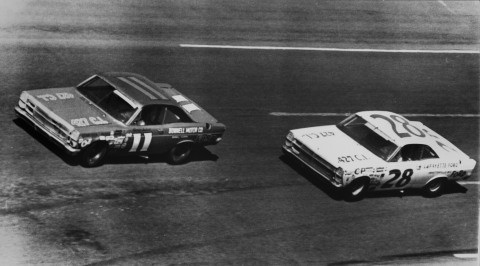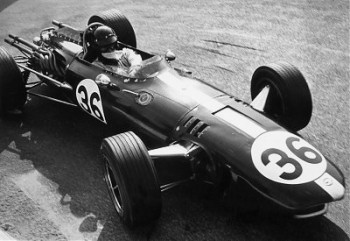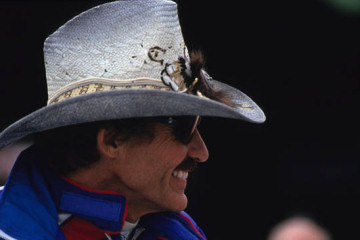The Way It Is/ Will their like occur again?
by Gordon Kirby Ah 1967, a fine year it was. The Beatles released 'Sergeant Pepper's Loney Hearts Club Band' in 1967 and on the big screen Paul Newman was starring in 'Cool Hand Luke' while Dustin Hoffman was making it big in 'The Graduate'. In motor racing, Jim Clark won the Dutch Grand Prix at Zandvoort on the debut of Colin Chapman's Lotus 49 powered by Keith Duckworth's Ford/Cosworth V-8. Clark was beaten to the world championship by Denny Hulme and Jack Brabham in their more proven and reliable Brabham-Repcos, but with Clark and Graham Hill at the helm the Cosworth age had arrived in Grand Prix racing.
Ah 1967, a fine year it was. The Beatles released 'Sergeant Pepper's Loney Hearts Club Band' in 1967 and on the big screen Paul Newman was starring in 'Cool Hand Luke' while Dustin Hoffman was making it big in 'The Graduate'. In motor racing, Jim Clark won the Dutch Grand Prix at Zandvoort on the debut of Colin Chapman's Lotus 49 powered by Keith Duckworth's Ford/Cosworth V-8. Clark was beaten to the world championship by Denny Hulme and Jack Brabham in their more proven and reliable Brabham-Repcos, but with Clark and Graham Hill at the helm the Cosworth age had arrived in Grand Prix racing.
In America, motor racing was huge and richly-varied with great stars like A.J. Foyt, Mario Andretti, Dan Gurney, Phil Hill, Parnelli Jones, Bobby and Al Unser, Richard Petty, David Pearson and Cale Yarborough. Striking a stark contrast to today, American drivers, teams and races were big players in international motor racing.
The Indy 500 was unrivalled in 1967 as the world's biggest race with almost $750,000 in prize money and more than $170,000 going to the winner, much more than anything on offer in Formula One at the time. And too the Daytona 24 hours and Sebring 12 hours were the opening rounds of the world sportscar championship, the equal of F1 in those days with the Watkins Glen 6 hours joining the schedule in 1968.
The original Can-Am series was also booming in 1967 with Bruce McLaren and Denny Hulme launching the 'Bruce and Denny Show'. More than thirty cars turned out for every race as the era of the Anglo-American V8-powered rear-engined sports/racer took off and the Can-Am emerged briefly as the world's second most important racing series.

© LAT USA
In 1967 Dan famously won the Le Mans 24 hours co-driving a factory Ford mk 4 with A.J. Foyt before going on to win the following weekend's Belgian GP at Spa aboard his own All American Racers Eagle-Weslake V-12. Gurney and Foyt's win was Ford's second in a row at Le Mans and the fastest twenty-four hour race in history at the time. Today it remains the fourth-fastest Le Mans race on record. Dan's delight in mastering Le Mans resulted in him creating a great motor racing tradition of spraying champagne in victory circle.
"There was a certain exuberance in realizing that after nine or ten attempts I had finally won the thing," Dan recalls. "It was a special moment because the Ferrari team was very strong at that time. So it was a huge success for the Ford Motor Company and for A.J. and me. It was the United States against Europe. It was just a terrific feeling and a great moment. We were up there on the podium and they handed us the magnum of champagne. The photographers down below us were looking expectantly and the whole thing just clicked. I thought, 'How could they take part in this as well?'
"So I figured, 'Why not?' And I used the champagne like a fire hose to spray the photographers. I think I also got Henry and Mrs. Ford! She didn't think it was as funny as the rest of us did. It was a spur of the moment thing, one of those things that don't happen very many times in a lifetime."
At Spa the next weekend Dan broke the track record during the race and averaged 145.74 mph in winning the 245-mile Belgian Grand Prix. It was the fastest road race in history at the time as Dan crossed the line more than one minute ahead of Jackie Stewart's BRM. After hearing 'The Star Spangled Banner' played during the victory ceremonies for the second time in seven days Dan was helicoptered to a nearby soccer stadium where a large group of fans, including many American servicemen stationed in Europe, cheered his remarkable achievement.
"It was a tremendous feeling to win at Spa with a car we had built right here in California and with an engine--our engine--that nobody else had," Gurney remarks. "When you realize how rare that sort of thing is for an American it became even more important as time went on."
But Dan's accomplishments were only the tip of the American iceberg in those days. Gurney's Le Mans co-winner Foyt was also at the height of his career, scoring his third Indy 500 win in 1967 and taking his fifth of seven USAC championships. At Indianapolis that year however, Foyt and everyone else were entirely outpaced by Parnelli Jones in Andy Granatelli's STP turbine car until a driveshaft joint failed with just three laps to go.
Parnelli was also at the peak of his career. He had already begun to transition to becoming a team owner and car builder and after the '67 500 Parnelli decided to retire from racing open-cockpit cars although he continued to win in Trans-Am cars and Baja-style off-road machines. It's also worth noting that the top five in that year's USAC Championship--Foyt, Mario, Bobby Unser, Gordon Johncock and Al Unser Sr.--went on to win a collective total of 218 Indy car races and seventeen USAC and CART championships. A red letter year to be sure.

© LAT USA
What caught the racing writers' attention was Mario's two broader accomplishments that year. He drove a Holman-Moody Ford stock car to win February's Daytona 500, trouncing Petty and all the other NASCAR stars at their own game. Andretti also won the following month's Sebring 12 Hours, co-driving a Ford mk 4 with Bruce McLaren as he began to demonstrate the skills that made him one of the most versatile drivers the sport has ever seen.
"That was quite a year," Mario recalls. "Both Foyt and I had our ups and downs and so did the Unsers. We were all capable of running up front at almost every race, but none of us could ever put together a string of strong finishes. It's funny. I won 'Driver of the Year', which was a tremendous accolade, but that wasn't a year I felt good about. My friend Billy Foster was killed that year, Indy turned into a disaster, and I lost the championship at the last minute. I always said you can have 1967. I just wanted to move on."
In 1968 Mario made his F1 debut at Watkins Glen aboard a Lotus 49 and qualified spectacularly on the pole. In those halcyon days we expected American drivers and teams to compete around the world at the highest level. It was one of the attractions of a great worldwide sport. Phil Hill led the charge in the late fifties and early sixties as a factory Ferrari driver in sports cars and then F1, winning Le Mans three times (1958, '61 and '62, all with Olivier Gendebien) and taking the tragic 1961 F1 world championship.
Gurney then took up the flame with a passion driving with increasing success for Ferrari, BRM, Porsche and Brabham in F1 and for Ferrari, Maserati, Porsche, Shelby/Cobra and Ford in sports cars before launching All American Racers and the Eagle marque in 1966. During this time Dan became the most renowned and highly-rated American to race in Europe highlighted by his victories at Le Mans and Spa in 1967.
Of course, Phil Hill was in his final year of racing in 1967, retiring after winning long-distance sports car races at the Nurburgring in '66 and Brands Hatch in '67 and a Can-Am race at Laguna Seca in '66, all aboard a selection of Jim Hall's Chaparrals. Nor should we forget Richie Ginther, factory Ferrari driver in 1960 and '61, second in the '62 world championship with BRM and winner for Honda of the 1965 Mexican GP.
Ferrari's North American importer Luigi Chinetti was the key to introducing Hill, Gurney and Ginther to Enzo Ferrari's team. But most of America's European racing adventure of the sixties and seventies was bankrolled by tire giants Goodyear and Firestone and also by the Ford Motor Company following Henry Ford II's failed 1964 attempt to buy Ferrari.

© mazdaraceway.com
After pulling out of F1, Parnelli's team transformed its F1 car into a turbocharged Indy car that rewrote the history of Indy car racing as smaller, lighter turbo Cosworth V-8-powered Indy cars blew off the traditional four-cylinder Offenhauser and Foyt/Ford V-8s. But by 1978 Jones and his partner Vel Miletich had decided Indy car racing was a commercial loser and closed the doors after winning two Indy 500s, three USAC championships and 58 Indy car races.
"The economics were impossible," Parnelli observed. "If we had $500,000 in sponsorship we were spending $1 million and if we had $1 million in sponsorship we were spending $2 million. We could never get ahead. Every year was costing us more money."
The last American team to win an F1 race was Penske Racing back in 1976. Roger Penske ran an F1 team, like VPJ, from late 1974-'76 with Mark Donohue driving in 1974 and the first half of '75 and John Watson replacing Donohue after Mark was killed in Austria in 1975. Watson won the next year's Austrian GP but at the end of the season Penske withdrew from F1 because, like Gurney in 1968, his sponsors--Goodyear and First National City Bank--wanted Roger to focus on racing at home in America.
The last American team to race in F1 was Carl Haas's Beatrice-Ford team that competed in 1985 and '86 with Alan Jones and Patrick Tambay driving. But Beatrice was taken over by a leveraged buyout in '86 and the sponsorship and team came to an abrupt end.
When Mario Andretti scored his last Grand Prix victory at Zandvoort in 1978 little did we suspect that it would be the last F1 win on record for an American driver. After Mario retired from F1 at the end of 1982 the only American driver to compete regularly in F1 was Eddie Cheever who would achieve the distinction of starting the most Grands Prix of any American.
The only Americans to race in F1 over the last twenty years were Michael Andretti in 1993 and Scott Speed in 2006 and '07. By the end of the twentieth century high profile American drivers and teams had vanished without trace from the top levels of international racing.
In fact, much the same can be said about American drivers and car builders in Indy car racing. All American Racers' 34-year run of building Eagle Indy cars came to an end in 1999. Penske also stopped building his own Indy cars--albeit in England--in 1999 and started buying customer cars, first from Reynard, then Dallara.

© Paul Webb
We were left with Al Unser Jr., Michael Andretti and Bobby Rahal and for a few years, despite the CART/IRL split everything seemed fine as new foreign stars like Alex Zanardi, Juan-Pablo Montoya and Gil de Ferran arrived and won successive CART championships from 1997-2001.
But as Rahal retired at the end of '98 and Al Jr. and Michael's careers wound-down the debilitating effects of the CART/IRL war took place as no new American superstars emerged to replace the great names from the sixties, seventies and eighties. Whether as drivers or personalities Jimmy Vasser and Sam Hornish simply didn't make the cut, while the likes of Jeff Gordon, Tony Stewart and Jimmie Johnson were drawn to NASCAR rather than Indy car racing. In 2010 the only Americans to race Indy cars on a regular basis were Ryan Hunter-Reay, Marco Andretti, Graham Rahal and Danica Patrick.
Sadly, the likelihood of any American ever repeating the feats of Phil Hill, Dan Gurney or Mario Andretti appear to be exceedingly slim, if not impossible. All of us hope for the best from the likes of Alex Rossi, Gabby Chaves, Josef Newgarden and Conor Daly but the only thing that's clear is that American racing's great days are long gone. For many reasons, both obvious and obscure, we seem to have turned into an unhappy version of Sergeant Pepper's Lonely Hearts Club Band.
We all wish it wasn't true and guys like Dan, Mario and Parnell become lost in frustration when trying to explain what's happened. They only wish that somehow, some way a new generation will follow in their glorious tire tracks.
*My best to all for the holidays. I'm taking a break over the holiday season until early or mid-January. Drive clean and safe.
Auto Racing ~ Gordon Kirby
Copyright 2010 ~ All Rights Reserved
Copyright 2010 ~ All Rights Reserved
Top of Page